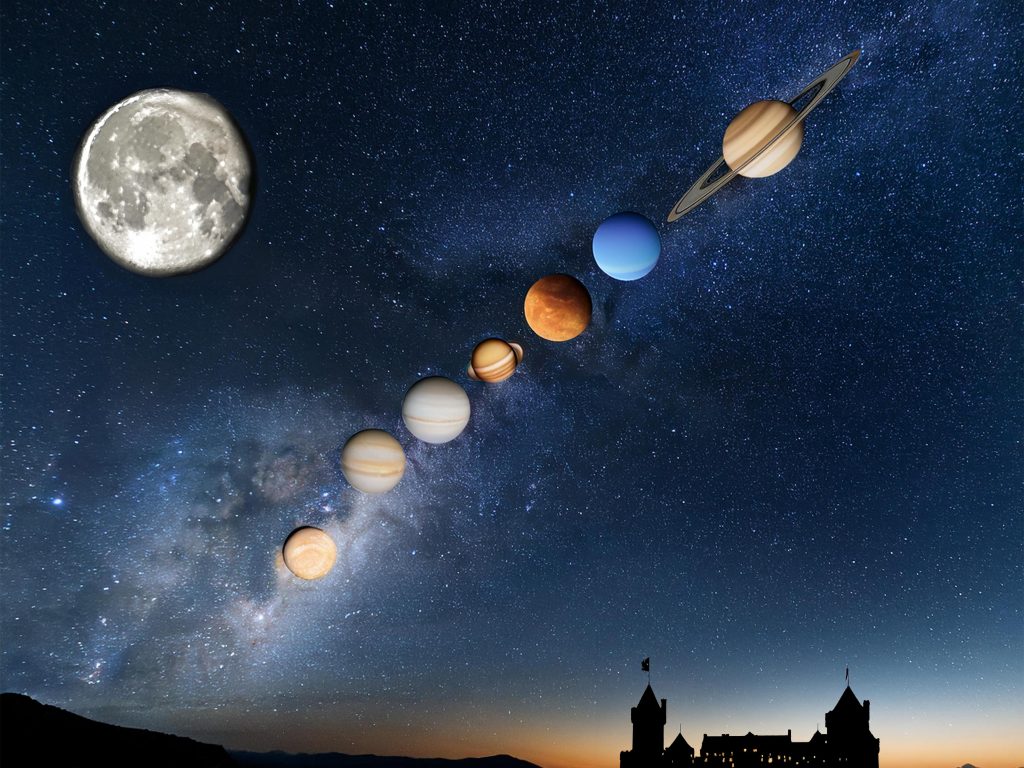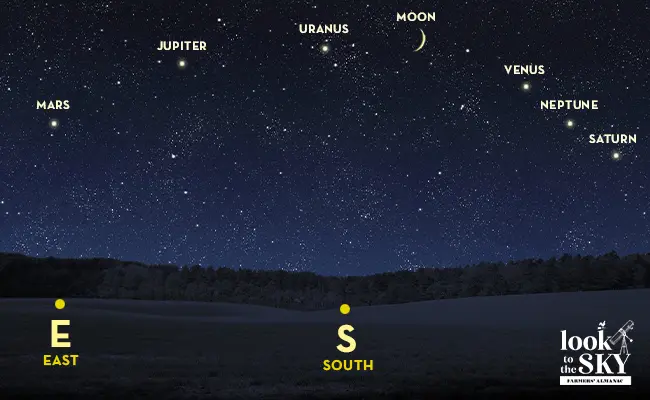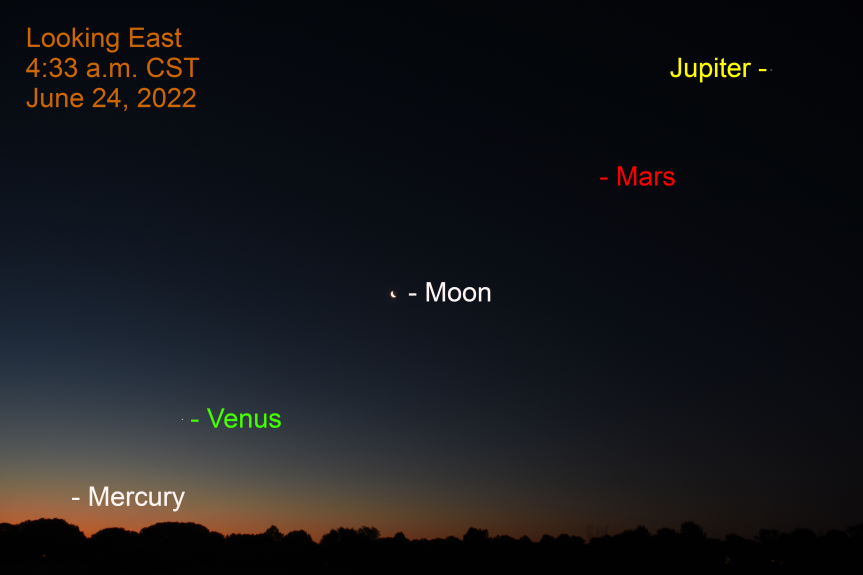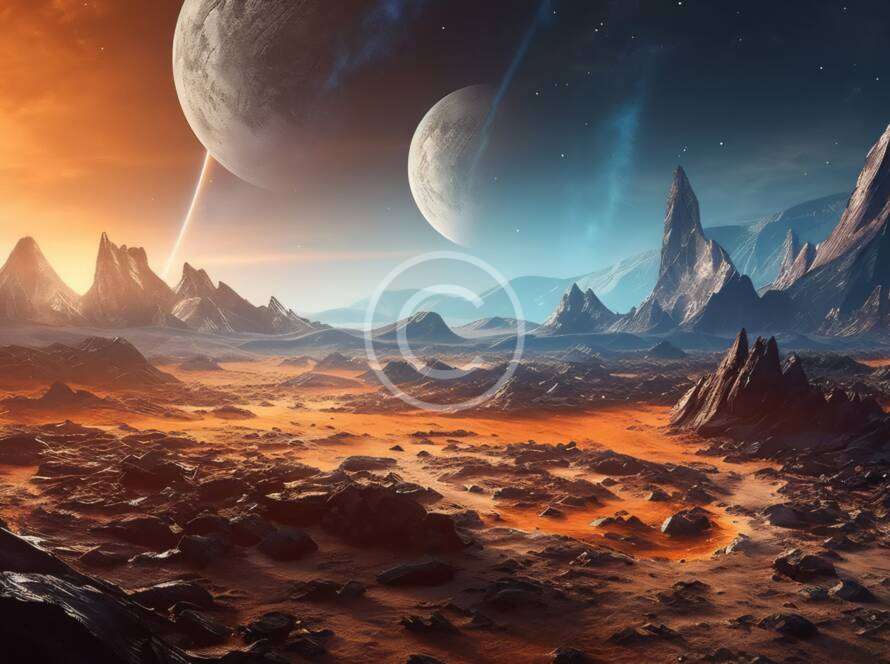In recent days, stargazers and astronomy enthusiasts worldwide have been treated to a rare and breathtaking celestial event: the alignment of six planets in the night sky. This phenomenon, known as a planetary alignment or conjunction, occurs when multiple planets appear to line up in a relatively straight line from the perspective of Earth. The alignment of six planets is a particularly rare occurrence, making this event a must-see for anyone with an interest in the cosmos.
The Planetary Lineup
Mercury, Venus, Mars, Jupiter, Saturn, and Uranus are the six planets involved in this alignment. These planets, which are all part of our solar system, are visible to the naked eye under the right conditions, although some may require binoculars or a telescope for a clearer view. The alignment has been visible in the early morning hours, just before sunrise, and has provided a stunning display for those who have ventured out to witness it.
- Mercury: The closest planet to the Sun, Mercury is often difficult to spot due to its proximity to the Sun’s glare. However, during this alignment, Mercury has been visible low on the horizon just before sunrise.
- Venus: Known as the “Evening Star” or “Morning Star,” Venus is the brightest planet in the night sky and has been a prominent feature of this alignment. Its brilliance makes it easy to spot, even in light-polluted areas.
- Mars: The Red Planet, Mars, has been visible as a reddish dot in the sky. Its distinct color makes it easy to identify among the other planets.
- Jupiter: The largest planet in our solar system, Jupiter, has been shining brightly during this alignment. Its four largest moons, known as the Galilean moons, are also visible through a telescope.
- Saturn: Known for its stunning ring system, Saturn has been visible as a golden-hued point of light. While its rings are not visible to the naked eye, they can be seen with a small telescope.
- Uranus: The seventh planet from the Sun, Uranus, is the faintest of the six planets in this alignment. It requires binoculars or a telescope to be seen clearly, but its inclusion in this event adds to the rarity and excitement.
The Science Behind Planetary Alignments
Planetary alignments occur when the orbits of the planets bring them into a configuration where they appear to line up from our vantage point on Earth. While the planets are not actually in a straight line in space, their positions relative to Earth create the illusion of alignment. This phenomenon is a result of the planets’ elliptical orbits around the Sun, which occasionally bring them into proximity with one another.
The alignment of six planets is particularly rare because it requires the orbits of multiple planets to coincide in such a way that they all appear in the same region of the sky. The last time a similar event occurred was in 2005, and the next one is not expected until the 2040s. This makes the current alignment a once-in-a-generation opportunity for stargazers.
Viewing the Alignment
To witness this celestial event, it is best to find a location with a clear view of the eastern horizon, away from city lights and light pollution. The alignment is most visible in the early morning hours, just before sunrise. Here are some tips for viewing the alignment:
Patience: Planetary alignments can take time to observe, as the planets rise gradually over the horizon. Be prepared to spend some time outside, and dress warmly if necessary
Timing: The best time to view the alignment is about 30 to 60 minutes before sunrise. This is when the planets are highest in the sky and most visible.
Location: Find a location with a clear view of the eastern horizon. A high vantage point, such as a hill or rooftop, can provide an unobstructed view.
Equipment: While brighter planets like Venus and Jupiter can be seen with the naked eye, a pair of binoculars or a small telescope will enhance the viewing experience, especially for fainter planets like Uranus.
Weather: Clear skies are essential for viewing the alignment. Check the weather forecast in advance and choose a night with minimal cloud cover.


The Significance of Planetary Alignments
Planetary alignments have fascinated humans for centuries. In ancient times, they were often seen as omens or signs from the gods. Today, we understand the science behind these events, but they still hold a sense of wonder and awe. Alignments like this one provide an opportunity to reflect on our place in the universe and the vastness of space.
For astronomers, planetary alignments offer a unique opportunity to study the planets and their movements. By observing the positions and brightness of the planets during an alignment, scientists can gather valuable data that contributes to our understanding of the solar system.
The Role of Technology in Observing Celestial Events
Advancements in technology have made it easier than ever to observe and document celestial events like planetary alignments. Smartphones and digital cameras allow amateur astronomers to capture stunning images of the night sky, while apps and software can help identify planets and constellations in real time.
Telescopes equipped with computerized tracking systems can automatically locate and follow planets as they move across the sky, making it easier for observers to keep the planets in view. Online platforms and social media have also made it possible for people around the world to share their experiences and images of the alignment, creating a global community of stargazers.
The Impact of Light Pollution
One of the challenges of observing celestial events like planetary alignments is light pollution. The artificial light from cities and towns can obscure the night sky, making it difficult to see faint objects like stars and planets. To fully appreciate the beauty of the alignment, it is best to find a location away from urban areas where the night sky is darker.
Efforts to reduce light pollution, such as using shielded lighting and turning off unnecessary lights at night, can help preserve the natural beauty of the night sky for future generations. Organizations like the International Dark-Sky Association work to raise awareness about the impact of light pollution and promote responsible lighting practices.
The Cultural and Historical Significance of Planetary Alignments
Throughout history, planetary alignments have been seen as significant events by various cultures. In ancient Mesopotamia, for example, the alignment of planets was believed to influence the fate of kings and nations. The Mayans and other Mesoamerican civilizations used planetary cycles to create complex calendars and predict celestial events.
In more recent times, planetary alignments have been the subject of speculation and conspiracy theories. Some have claimed that alignments can trigger natural disasters or other catastrophic events, although there is no scientific evidence to support these claims. Despite the myths and misconceptions, planetary alignments remain a source of fascination and inspiration for people around the world.

The Future of Planetary Alignments
While the current alignment of six planets is a rare event, there are other planetary alignments to look forward to in the coming years. In 2025, for example, there will be a conjunction of Jupiter and Saturn, known as the “Great Conjunction,” which occurs approximately every 20 years. Other alignments involving fewer planets are more common and can still provide stunning views of the night sky.
As our understanding of the solar system continues to grow, so too does our ability to predict and observe these celestial events. Advances in technology and astronomy will allow us to study planetary alignments in greater detail, providing new insights into the dynamics of our solar system.

Conclusion
The alignment of six planets in the night sky is a rare and awe-inspiring event that offers a unique opportunity to connect with the cosmos. Whether you are an experienced astronomer or a casual stargazer, this alignment is a reminder of the beauty and complexity of the universe we inhabit. By taking the time to observe and appreciate this celestial phenomenon, we can gain a deeper understanding of our place in the cosmos and the wonders that lie beyond our world.
As the planets continue their eternal dance across the night sky, we are reminded of the enduring fascination that the heavens hold for humanity. The alignment of six planets is a fleeting moment in the grand tapestry of the universe, but it is one that will be remembered and cherished by those who have had the privilege of witnessing it. So, grab your binoculars, find a dark spot, and look up—the cosmos is waiting to reveal its secrets.


